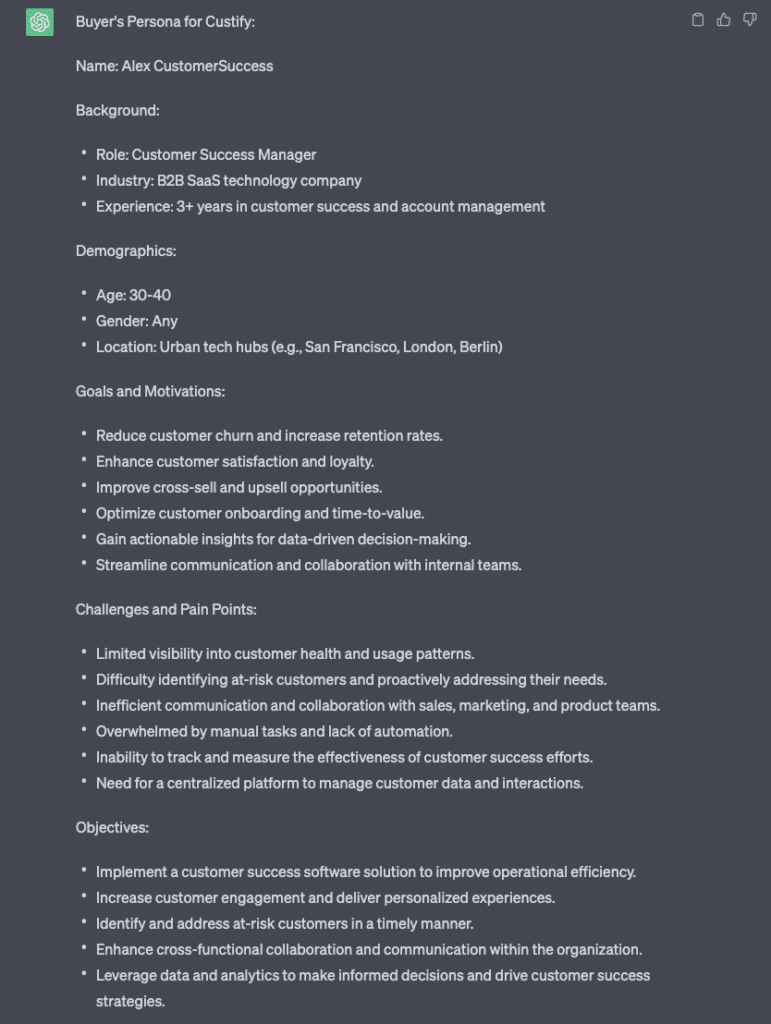ChatGPT has taken many industries by storm, and customer success is no exception. But let’s be pragmatic — how accurate is the hype, really? Can ChatGPT actually help you transform your CS team into a hyperefficient money-making machine?
In this article, I’ll separate the facts from the fiction, cover the limitations of ChatGPT, and suggest a few practical, CS-specific use cases for the tool.
5 Prompts & Practical CS Use Cases for ChatGPT
Let’s skip the further ado and jump right into the thing you opened this article for — practical use cases of ChatGPT in a CS setting.
I will be using Custify as an example where applicable, so you’ll need to customize the prompts to be relevant to you.
1. Create a Buyer Persona/ICP
As a CSM, you shouldn’t need ChatGPT telling you the Buyer Persona or ICP for your own brand. However, this prompt can come in handy when doing competitor research.
Prompt: Hey, ChatGPT. Create a detailed Buyer Persona for Custify — a customer success software company in the B2B SaaS industry. Outline the specific responsibilities, pain points, and goals that Custify should target.
ChatGPT’s Output:
Notes: First, keep in mind that this prompt will not work for every company. If a company was established after September 2021 (ChatGPT’s knowledge cut-off point — more on that later), the chatbot will be unable to produce a result.
A way to take this prompt further is to first feed a company’s job descriptions to ChatGPT. Then, you can ask the chatbot to create an ICP/Buyer Persona based on the job info. This approach was discovered by Jordan Crawford of Blueprint — check out his video below:
2. Create Meeting/Call/Webinar Summaries
ChatGPT-4 is, perhaps, the strongest when it comes to processing and interpreting data — including chunks of texts such as meeting or webinar transcripts.
Here’s what happened when I asked it to summarize some of the transcript from our recent webinar with Irit Eizips.
Prompt: Can you please summarize the key points and ideas of the webinar transcript below for a person who works in customer success or account management?
ChatGPT’s Output:
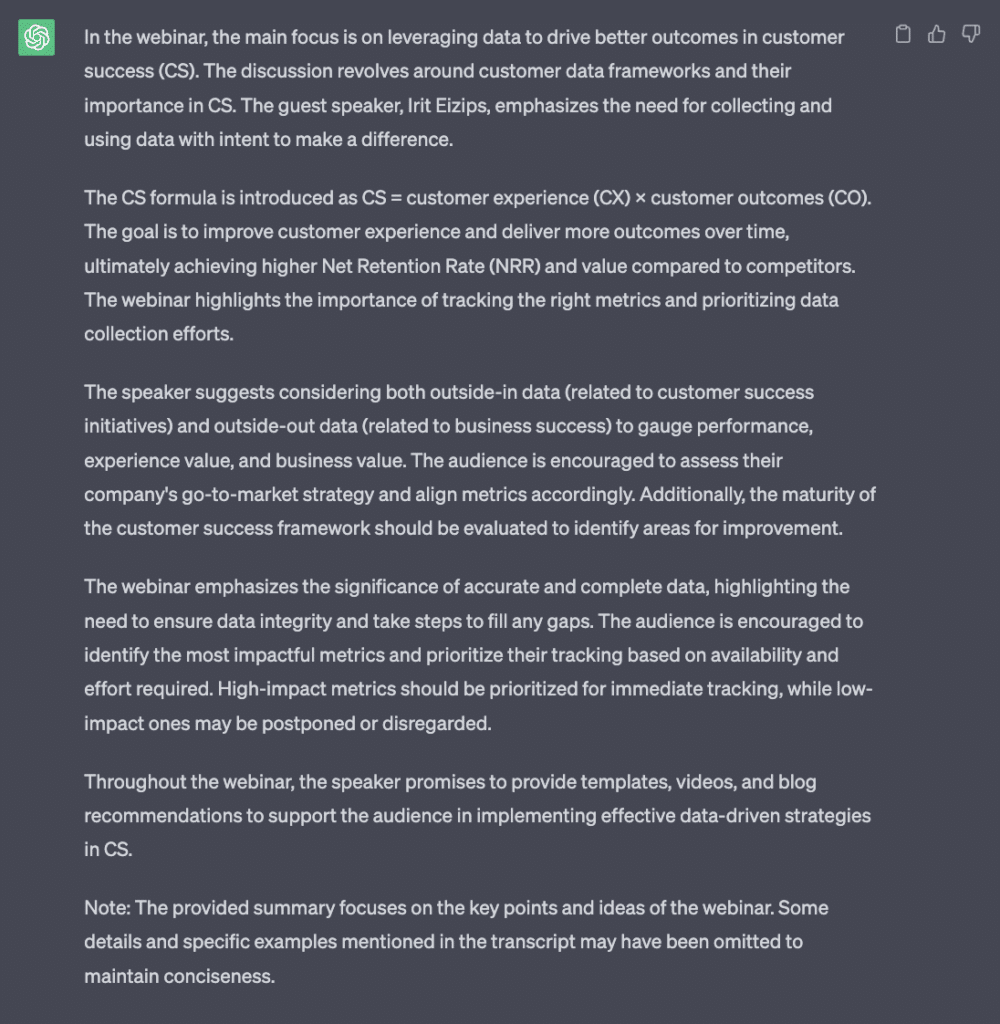
Notes: This summary is pretty on point — and I didn’t even need to use a sophisticated prompt. There is just a tiny caveat. I had to paste the actual transcript into the chat, and I could only do a portion because there is a character limit.
However, if you’re a ChatGPT Plus subscriber, you get access to a newer version of the chatbot based on the upgraded GPT-4 model. That version is actually capable of accessing links and scanning webpages, so you wouldn’t need to paste the raw text.
3. Create Email Drafts
Writing an email to a customer may seem like a trivial task. But when the emails to send add up, they can take up a considerable amount of a CSM’s time. Fortunately, ChatGPT can help, as it’s capable of creating outstanding emails.
Prompt: At Custify, we will be releasing a new feature called the Customer Portal next month. One of our customers tried it out in Beta, and they were unhappy with it. The customer is called Kramer Industries, and the main contact is John Kramer. They use our product every day, but we feel like they haven’t tried all the features, and not all their team members have tested it. Can you make a personal, conversational email saying we understand their frustrations and would like to have the other members of his team test it?
ChatGPT’s Output:
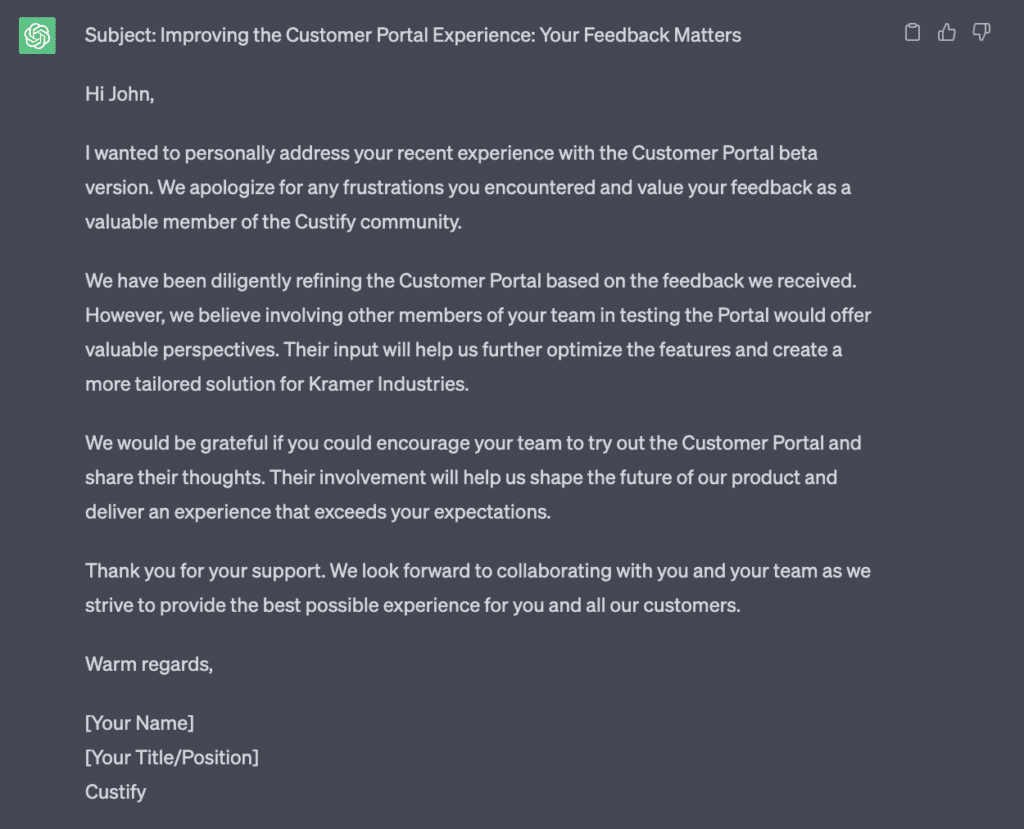
Notes: As long as you add specific info about your customer and their situation, the chatbot can produce an extremely well-written email. You can then personalize it even further to reflect all the tiny details and quirks of your relationship with the customer.
4. Create CS Playbooks & Campaigns
Yes, ChatGPT is even capable of creating entire CS playbooks or campaigns. However, for these the process is a bit more complicated than just one prompt.
For this example, let’s create a series of emails and messages for a churn prevention playbook using the chatbot.
Prompt 1 — Context + Email 1: I am a customer success manager at Custify — a customer success software tool that helps B2B SaaS companies improve their product adoption, customer retention, and revenue.
One of the clients I am responsible for is Cramer Industries, with the CEO & Founder John Cramer as my main point of contact. Cramer Industries’ product is a project management software, and they use Custify to keep track of their customers, their customers’ health, and to identify upsell and expansion opportunities.
However, Cramer Industries’ latest payment to us failed. We are not sure whether this was intentional (they don’t want to use our tool anymore) or unintentional (the credit card they used for payments had expired). In any case, if they fail to pay the invoice in the next 15 days, they’ll stop being our customer.
Your task is to create a customer success playbook that will help me reach out to John Cramer, resolve the failed payment issue, and retain the Cramer Industries account. Let’s start by creating an initial notification email to inform the customer about the failed payment.
ChatGPT’s Output 1:

Prompt 2 — Email 2: Great. Now, assume that this email remained unanswered. I need to send another email with a more urgent reminder about the customer’s failed payment. This second email needs to be very short, as we can assume that the first email informed the customer of the issue. So, write another email that’s very short, even more personal, and even more conversational.
ChatGPT’s Output 2:
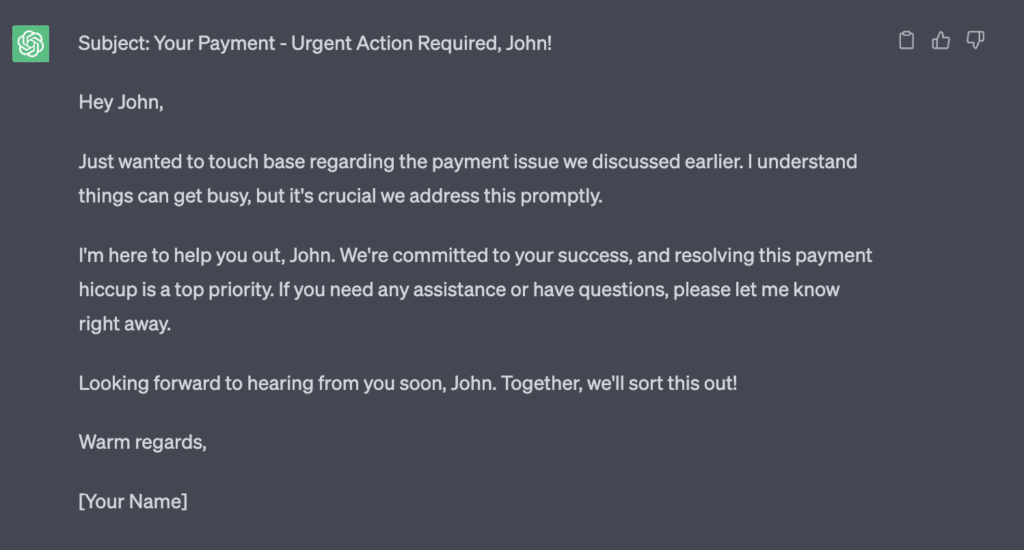
Prompt 3 — SMS 1: Fantastic. However, John failed to respond to both emails, so now, I will try to reach him via other channels. Let’s start with SMS — write an SMS message similar in its contents to Email 1. It needs to be an initial notification message about Cramer Industries’ failed payment. Keep in mind that SMS messages can be up to 160 characters in length.
ChatGPT’s Output 3:

Prompt 4 — SMS 2: Great. Now assume that John isn’t responding to this message, either. Write another SMS message that is more urgent and asks him to fix his failed payment or risk losing his account.
ChatGPT’s Output 4:

Prompt 5 — App Notification: Good. Finally, if anything else fails, we can try to reach John directly via the Custify app. Create the text for an app notification to John about their failed payment. The notification should feature a short headline of a few words, as well as a slightly longer body text.
ChatGPT’s Output 5:

Notes: And there you have it! You can proceed to compile all these into a single general playbook that can be used for any of your customers should their payment fail.
You can also create similar sequences for outreach or onboarding. And for even more convenience, you can also set up your prompts as templates and continuously reuse them.
5. Run Trainings/Simulations for Your CSMs/SDRs
Talking to customers or prospects can be a bit scary, to be completely honest. Especially when you’re not sure how they’re feeling about your product. And while you can’t read their minds, you can simulate different types of conversations with prospects or customers using ChatGPT.
In other words, you can set up scenarios in the chatbot and use them to train your CSMs or SDRs how to navigate different conversations.
Once again, this will take more than just one prompt, and you need to be very descriptive. Let’s test it out!
Prompt 1 — Context: Let’s play out a scenario. Imagine I am a sales development representative at Custify — a customer success software tool that helps B2B SaaS companies improve their product adoption, customer retention, and revenue. My goal is to reach out to leads and prospective clients to, hopefully, convert them into paying customers.
You, on the other hand, are playing the role of a Customer Success Manager at Cramer Industries, a B2B SaaS company. Cramer Industries’ product is a project management software, and you’re looking for a tool that can help you keep better track of your customers.
Now, choose a name and introduce yourself.
ChatGPT’s Output 1:

Prompt 2 — Pitch: I am now reaching out to you with a sales pitch because I believe that Custify is the right tool for your needs. How should I open the conversation?
ChatGPT’s Output 2:
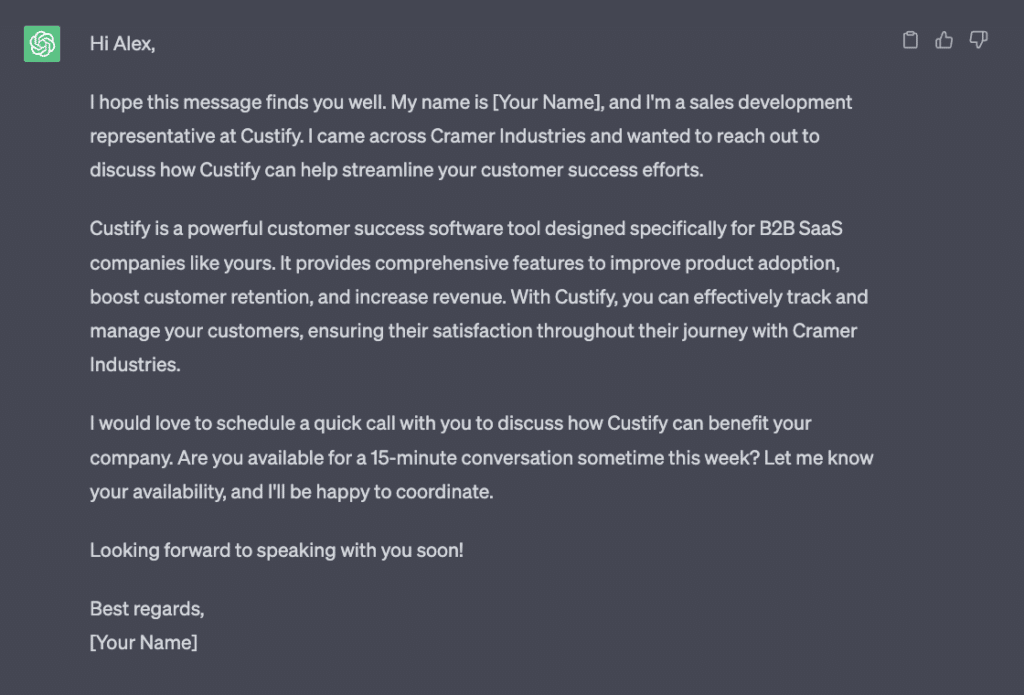
Prompt 3 — Scenarios: How would you respond to this message as the CSM at Cramer Industries? Create a response for each of the following scenarios:
— You have heard about Custify and are excited about the opportunity.
— You’re very skeptical about Custify.
Make the responses short and straightforward, just like the pitch.
ChatGPT’s Output 3:
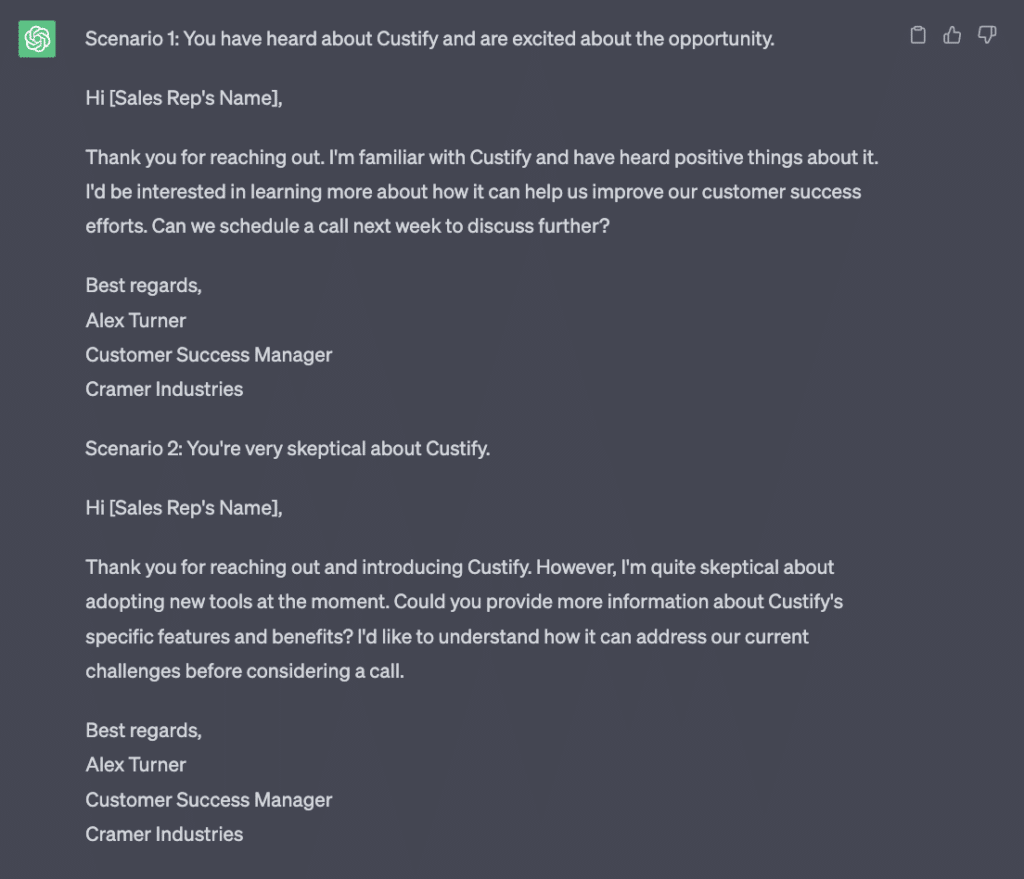
Prompt 4 — Responses: Great! Now, how should I respond to each one of these messages?
ChatGPT’s Output 4:
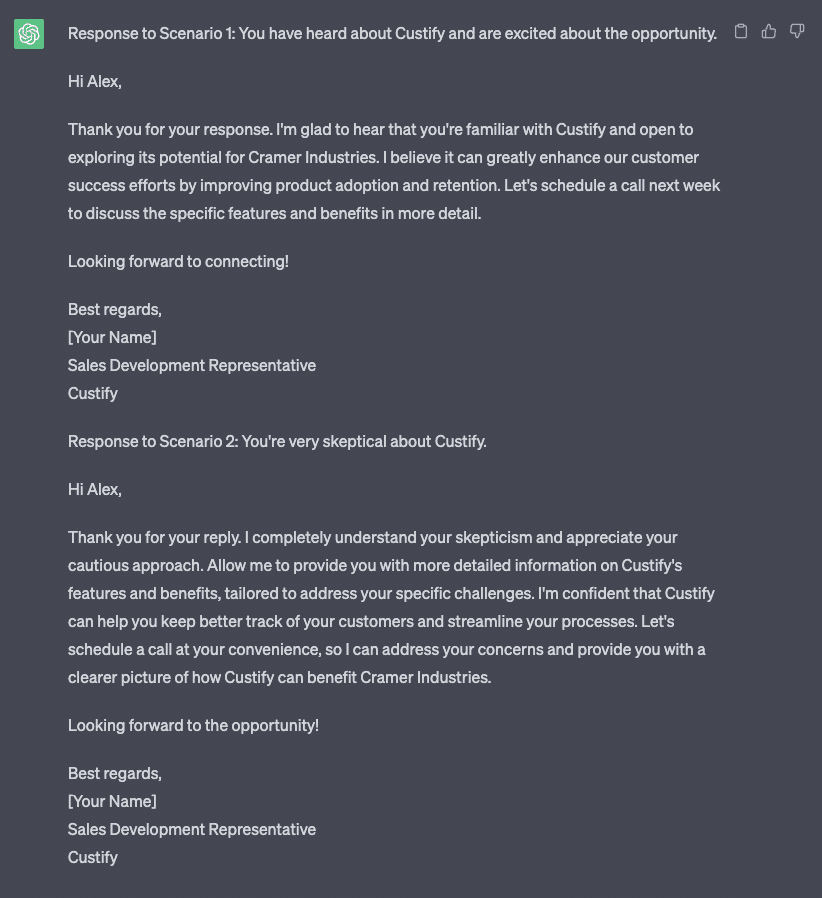
Notes: You can take this simulation as far as you want. For instance, you can ask ChatGPT to generate a very aggressive response to the pitch and a corresponding counter-argument. Or, add some very specific objections to specific features that the lead would have in this scenario — the opportunities are almost endless.
What Are the Limitations of ChatGPT?
ChatGPT and other Large Language Models (LLMs) may be extremely capable of sounding like humans, but they’re highly unlikely to replace us (at least for now!) due to a few inherent design limitations.
Dodgy Accuracy
Perhaps the notable limitation of the famed chatbot is its inconsistent accuracy. Sometimes, you might have to feed the same prompt several times into ChatGPT to get an answer that is consistently accurate.
Or, rather, you may get conflicting information from the bot if you input the same prompt several times in a row. This may cause what AI researchers and enthusiasts refer to as “hallucinations” — output that sounds human and legible but isn’t factually correct.
An example of this that commonly pops in blogs and enthusiast communities is this user trying to learn about Argentina’s wins in the FIFA World Cup:
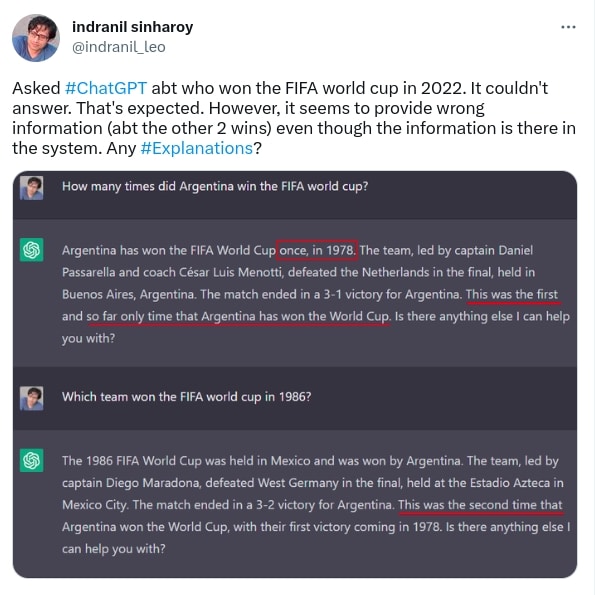
[Source]
Now, in my experience, these inconsistencies are relatively rare. So, inconsistent outputs are not necessarily a limitation in itself — instead, it’s more of a “Boy Who Cried Wolf” situation. That is, the more you encounter these inconsistencies when using ChatGPT, the more you might start doubting its abilities.
And in the end, you might spend more time fact-checking the bot’s output than coming up with prompts. The result would be a bit ironic: your efficiency will suffer because of the tool that’s supposed to make you more efficient.
Privacy Concerns
Between a recent data leak and the coincidental regulatory pushback against the platform in Italy because of GDPR laws, data security remains a concern with ChatGPT. In fact, Italy’s case best illustrates these concerns as an inherent outcome of the platform’s design.
Remember how the chatbot was trained using billions of data points collected from around the web? Well, it just so happens that among those data points was personal information of millions and millions of people. Naturally, this information was collected, stored, and used without the people’s knowledge and consent. This is precisely something that GDPR and similar regulations seek to prevent.
And that’s not the end of the story. Just like every other LLM, ChatGPT is ever-evolving. Meaning, it continuously learns from every prompt and every output. In other words, once you input something into ChatGPT, that information will become part of the model and help teach it.
But what does that all mean for CS teams or any other teams that handle sensitive customer data? Unfortunately, the real implications of ChatGPT’s data security issues are still a bit murky. The most common data security standards for organizations, such as ISO27001 or SOC2 do not account for AI just yet. The tool employs strict access controls to ensure only authorized personnel can access sensitive user data, enhancing the security measures already in place by OpenAI.
And even though OpenAI recently announced a set of measures to improve the data security of platform, it’s still not a good idea to feed the chatbot personal or sensitive data. And if you’re looking to sleep even tighter at night while using ChatGPT, you should opt for the API instead of the publicly available chatbot.
OpenAI doesn’t have access to the data processed by an API instance. As such, this would add another layer of security — especially if created in a safe environment such as a Microsoft Azure instance and you implement Azure logging.
Lack of Common Sense
Put bluntly, an LLM is an algorithm — and algorithms don’t comprehend information the same way that humans do. ChatGPT and other similar tools simply don’t have the capacity for abstract, critical thinking.
So, when you ask ChatGPT a question, it doesn’t conceptualize the answer in the same way that a human does. Instead, it generates a response based on the data patterns upon which it was trained. And it usually takes the easiest, fastest route to a coherent answer, all while failing to recognize the contextual subtleties of your question.
For instance, here’s ChatGPT’s first response to the idiom “If a tree falls in a forest and no one is around to hear it, does it make a sound?”:

When I ask it to elaborate on the answer, it still doesn’t recognize the idiom:

Only after I regenerate the response does it start talking about the idiom and not an actual tree:
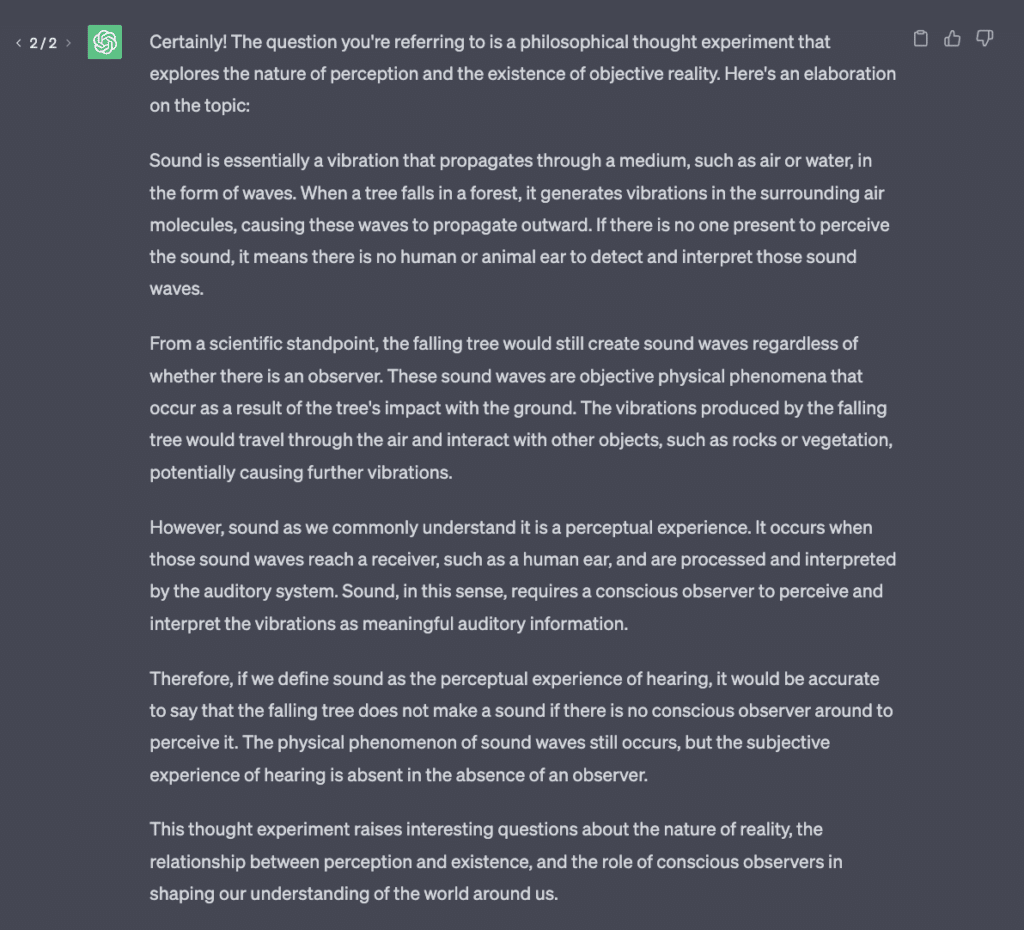
What I’m trying to say is: ChatGPT is a very capable tool, but it cannot replicate the expertise, intuition, and creativity of a human being. Then again, it wasn’t really designed to do that. Instead, it’s a tool — a tool that is only useful if you know what you’re doing with it.
The quality of the input always matches the quality of the output. Remember how detailed I had to make the prompts to get valuable content from ChatGPT? These prompts are precisely what you need to master.
Why You Need to Master Prompt Engineering
Prompt engineering is the art of creating specific, descriptive prompts that will generate your desired outputs. The more detailed and specific your prompts are, the more valuable and relevant ChatGPT’s outputs will be.
The main purpose of prompt engineering is to enrich your instance of the chatbot with contextual knowledge. In fact, context is extremely important if you want to get any value from the AI.
ChatGPT generates content based on the knowledge and data it already has. So, if you want it to generate content that is relevant to you, you need to train ChatGPT with corresponding contextual data first.
Consider the following example, courtesy of Lincoln Murphy — the top evangelist of ChatGPT in CS as of now. Let’s say you want to create a case study using the chatbot. To do that, you will need to feed two types of contextual data to the model: task data and session data.
Task data is more global and stays consistent between the different sessions within the chatbot — things like your style guide or templates. Meanwhile, session data is specific to each use case — in this situation, specific info relevant to the case study.
So, here’s what the contextualization and the case study creation process would look like:

[Source]
As you can see, you need to supply ChatGPT with plenty of context before it can generate content that is specific and unique for your use case.
And even then, you still need to have a clear understanding of what you’re trying to achieve beyond the prompts. No AI model can replace real human expertise, after all.
ChatGPT in CS: Assistant or Competitor?
If you ask me, AI is not coming for our jobs just yet. ChatGPT, Midjourney, and other advanced AI apps are not harbingers of doom and unemployment — even though they’re getting more capable by the day.
Sure, rapid technological advancement can be scary in its uncertainty. However, I think we need to take a more sober, objective look at AI tools and recognize that they are nothing but, well, tools. Assistants, if you will.
And like all tools, they’re only meant to make certain jobs easier, not steal them. Or, as Jeff Heckler beautifully puts it:
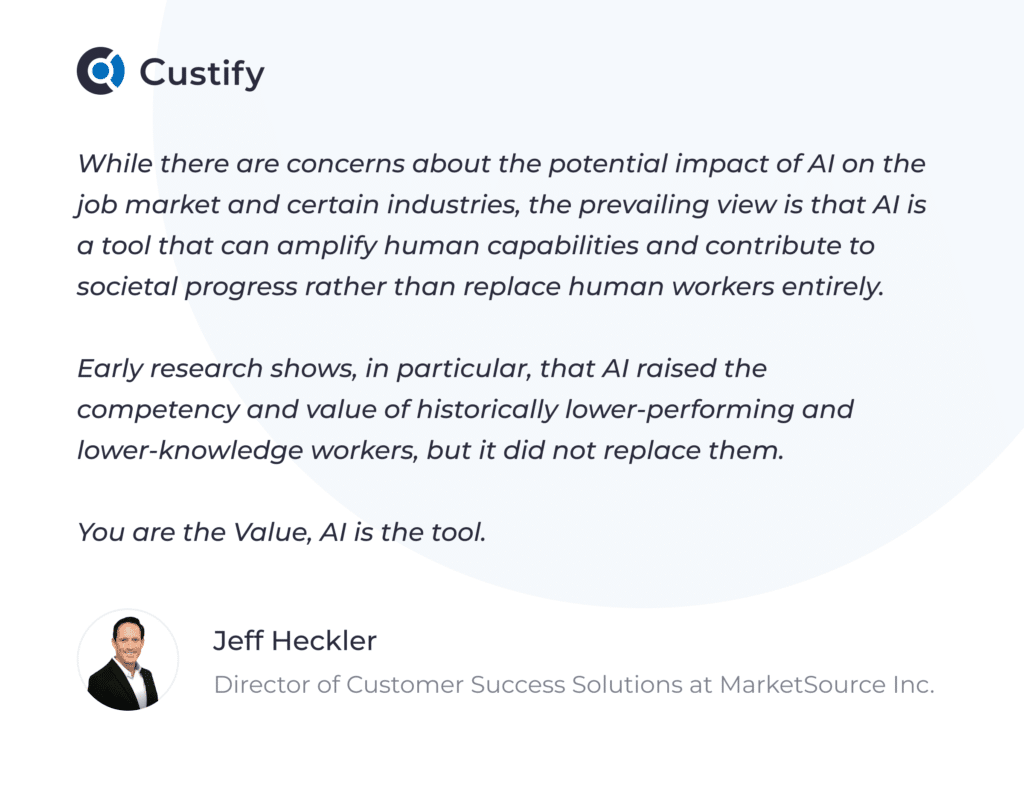
Of course, there are still valid reasons to be cautious about AI’s explosive growth. But I think we should stay optimistic. The likes of ChatGPT might just be ushering in a new industrial revolution. It would be foolish for us not to leverage these tools to reach new heights of productivity.
